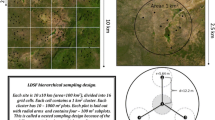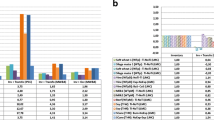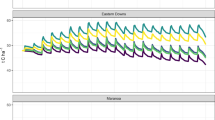Abstract
The question of whether organic farming leads to higher soil organic matter (SOM) levels in arable soils compared with conventional farming is an ongoing debate. Building on several studies reported in the literature, we hypothesize that the impact on SOM levels is not an intrinsic characteristic of any farming system but is the result of the actual structure of the farming system, in particular, the composition and management of crop rotations, and the availability and utilization of organic manure. The SOM balances for organic versus conventional farming in Germany are compared by considering data on the structure of organic and conventional farming systems from agricultural census reports and then applying the SOM balance model HU-MOD. Preliminary testing confirmed the applicability of the model using a survey on soil organic carbon (SOC) change and SOM balances in four long-term field experiments in Germany and Switzerland and found that more positive SOM balances coincided with higher SOC levels. We therefore conclude that, where the SOM supply level of organic farming systems is higher than in conventional management, a shift from conventional to organic agriculture would increase SOM levels. Upscaling using agricultural census data in Germany, we found that SOM balances of organic farming were more positive than for conventional farming in the scenarios without consideration of animal manure application, but SOM balances for the two systems were not different where animal manure application rates were assumed to be at the current average rate for all cropped land. However, in fact, animal manure availability and application shows strong regional variations, and it is likely that this would affect the mean cropland SOM balance if it were possible to calculate it based on such spatially disaggregated data. We confirm the applicability of simple SOM balance models to compare the impact of farming systems and cropland structures on SOC levels. More work is needed to develop data inputs at a sufficient spatial and structural resolution to support more detailed evaluation.

Similar content being viewed by others
References
Bellamy P, Loveland P, Bradley R, Lark R, Kirk G (2005) Carbon losses from all soils across England and Wales 1978−2003. Nature 437:245–248
Best H (2007) Organic agriculture and the conventionalization hypothesis: a case study from West Germany. Agric Hum Values 25:95–106
BLE (2012) Strukturdaten Ökologischer Landbau 2010. http://www.oekolandbau.de/fileadmin/redaktion/dokumente/service/Bio-Strukturdaten_2010.xlsx Accessed 29 March 2012
BMELV (2007) Agrarpolitischer Bericht der Bundesregierung 2007. German Federal Ministry of Agriculture and Food (BMELV) publication, Bonn
Britz W, Verburg P, Leip A (2011) Modelling of land cover and agricultural change in Europe: combining the CLUE and CAPRI-Spat approaches. Agr Ecosyst Environ 142:40–50
Brock C, Fließbach A, Oberholzer H, Schulz F, Wiesinger K, Reinicke F, Koch W, Pallutt B, Dittman B, Zimmer J, Hülsbergen K, Leithold G (2011) Relation between soil organic matter and yield levels of nonlegume crops in organic and conventional farming systems. J Plant Nutr Soil Sci 174:568–575
Brock C, Hoyer U, Leithold G, Hülsbergen KJ (2012) The humus balance model (HU-MOD): a simple tool for the assessment of management change impact on soil organic matter levels in arable soils. Nutr Cycl Agroecosyst 92:239–254
Carlgren K, Mattsson L (2001) Swedish soil fertility experiments. Acta Agr Scand B-S P 51:49–78
Debruck J (2003) Der viehlose Öko-Betrieb–die Problematik um Fruchtfolge und N-Kreislauf. Mitt Ges Pflanzenbauwiss 15:63–66
Deike S, Pallutt B, Christen O (2008) Investigations on the energy efficiency of organic and integrated farming with specific emphasis on pesticide use intensity. Eur J Agron 28:461–470
European Commission (2009): LUCAS 2009 (Land Use/Cover Area Frame Survey). Technical reference document C-1: general implementation, land cover and use, water management, soil, transect, photos. Surveyor instructions. http://epp.eurostat.ec.europa.eu/portal/page/portal/lucas/documents/Instructions_LUCAS2009m.pdf Accessed 6 June 2012
Fließbach A, Oberholzer H, Gunst L, Mäder P (2007) Soil organic matter and biological soil quality indicators after 21years of organic and conventional farming. Agr Ecosyst Environ 118:273–284
Foereid B, Høgh-Jensen H (2004) Carbon sequestration potential of organic agriculture in northern Europe—a modelling approach. Nutr Cycl Agroecosys 68:13–24
Foissner W (1992) Comparative studies on the soil life in ecofarmed and conventionally farmed fields and grasslands of Austria. Agr Ecosyst Environ 40:207–218
Freibauer A, Rounsevell M, Smith P, Verhagen J (2004) Carbon sequestration in the agricultural soils of Europe. Geoderma 122:1–23
Gosling P, Shepherd M (2005) Long-term changes in soil fertility in organic arable farming systems in England, with particular reference to phosphorus and potassium. Agr Ecosyst Environ 105:425–432
Gregorich EG, Drury CF, Baldock JA (2001) Changes in soil carbon under long-term maize in monoculture and legume-based rotation. Can J Soil Sci 81:21–31
Hepperly PR, Douds D, Seidel R (2006) The Rodale Institute Farming Systems Trial 1981 to 2005: long-term analysis of organic and conventional maize and soybean cropping systems. In: Raupp J, Pekrun C, Oltmanns M, Köpke U (eds) Long-term field experiments in organic farming, ISOFAR Scientific Series 1, Dr. Köster, Berlin, pp 15-32
Hülsbergen KJ, Abraham J, Wittmann C, Papaja S (2000) Die räumliche und zeitliche Variabilität der Humus- und Nährstoffgehalte auf Testflächen in Seeben. In: Hülsbergen KJ, Diepenbrock W (eds) Die Entwicklung von Fauna, Flora und Boden nach Umstellung auf ökologischen Landbau, Martin-Luther-Universität Halle-Wittenberg, Halle, pp 69-86
IFEU (2008) Nachhaltig nutzbares Getreidestroh in Deutschland. Positionspapier. Institut für Energie- und Umweltforschung Heidelberg GmbH (IFEU), Heidelberg. http://www.ifeu.de/landwirtschaft/pdf/IFEU%20-%20Positionspapier%20Stroh.pdf. Accessed 29 March 2012
ISO 10694 (1995) Soil quality—determination of organic and total carbon after dry combustion (elementary analysis). International Standardization Organization
Kirchmann H, Bergstroem L (2008) Organic crop production. Ambitions and limitations. Springer Science + Business Media B.V, [Dordrecht]
Kutsch W, Aubinet M, Buchmann N et al (2010) The net biome production of full crop rotations in Europe. Agric Ecosyst Environ 139:336–345
Kuzyakov Y, Friedel JK, Stahr K (2000) Review of mechanisms and quantification of priming effects. Soil Biol Biochem 32:1485–1498
Lal R (2004) Soil carbon sequestration impacts on global climate change and food security. Science 304:1623–1627
Lal R (2006) Enhancing crop yields in the developing countries through restoration of the soil organic carbon pool in agricultural lands. Land Degrad Dev 17:197–209
Leifeld J, Fuhrer J (2010) Organic farming and soil carbon sequestration: what do we really know about the benefits? Ambio 39:585–599
Leifeld J, Reiser R, Oberholzer H (2009) Consequences of conventional versus organic farming on soil carbon: results from a 27-year field experiment. Agron J 101:1204
Leip A, Marchi G, Koeble R, Kempen M, Britz W, Li C (2008) Linking an economic model for European agriculture with a mechanistic model to estimate nitrogen and carbon losses from arable soils in Europe. Biogeosciences 5:73–94
Leithold G (1991) Über den Zusammenhang von Humus und Stickstoff im System Boden-Pflanze und Möglichkeiten einer quantitativen Beschreibung. Wissenschaftliche Zeitschrift der Universität Halle XXXX´91M3:67-75
Liu X, Herbert SJ, Hashemi AM, Zhang X, Ding G (2006) Effects of agricultural management on soil organic matter and carbon transformation—a review. Plant Soil Environ 52:531–543
Mäder P, Fließbach A, Dubois D, Gunst L, Fried P, Niggli U (2002) Soil fertility and biodiversity in organic farming. Science 296:1694–1697
Mäder P, Fließbach A, Dubois D, Gunst L, Jossi W, Widmer F, Oberson A, Frossard E, Oehl F, Wiemken A, Gattinger A, Niggli U (2006) The DOK experiment (Switzerland). In: Raupp J, Pekrun C, Oltmanns M, Köpke U (eds) Long-term field experiments in organic farming, ISOFAR Scientific Series 1, Dr. Köster, Berlin, pp 41-58
Marinari S, Mancinelli R, Campiglia E, Grego S (2006) Chemical and biological indicators of soil quality in organic and conventional farming systems in central Italy. Ecol Indic 6:701–711
Mazzoncini M, Canali S, Giovannetti M, Castagnoli M, Tittarelli F, Antichi D, Nannelli R, Cristani C, Bàrberi P (2010) Comparison of organic and conventional stockless arable systems: a multidisciplinary approach to soil quality evaluation. Appl Soil Ecol 44:124–132
Munro TL, Cook HF, Lee HC (2002) Sustainability indicators used to compare properties of organic and conventionally managed topsoils. Biol Agric Hortic 20:201–214
Nissen TM, Wander MM (2003) Management and soil-quality effects on fertilizer-use efficiency and leaching. Soil Sci Soc Am J 67:1524–1532
Osterburg B, Schmitt T (2008) Weiterentwicklung der Berechnung regionaler Stickstoffbilanzen am Beispiel Niedersachsen. Landbauforschung - vTI Agri For Res 58:45–58
Panten K, Rogasik J, Godlinski F, Funder U, Greef JM, Schnug E (2009) Gross soil surface nutrient balances: the OECD approach implemented under German conditions. Landbauforschung-vTI Agr For Res 59:19–28
Papritz A, Webster R (1995) Estimating temporal change in soil monitoring.1. Statistical theory. Eur J Soil Sci 46:1–12
Parton WJ, Schimel DS, Cole CV, Ojima DS (1987) Analysis of factors controlling soil organic matter levels in Great Plains Grasslands. Soil Sci Soc Am J 51:1173–1179
Piorr A, Werner W (1998) Nachhaltige landwirtschaftliche Produktionssysteme im Vergleich. Bewertung anhand von Umweltindikatoren. DLG-Verl., Frankfurt a. Main [u.a.]
Pulleman M, Jongmans A, Marinissen J, Bouma J (2003) Effects of organic versus conventional arable farming on soil structure and organic matter dynamics in a marine loam in The Netherlands. Soil Use Manage 19:157–165
Reganold J (1988) Comparison of soil properties as influenced by organic and conventional farming systems. Am J Alternative Agr 3:144–155
Reinicke F, Hülsbergen KJ, Christen O (2003) Bewertung von Anbausystemen des integrierten und ökologischen landbaus unter den bedingungen des mitteldeutschen Trocken-Lößgebietes in einem Dauerfeldversuch. Mitt Ges Pflanzenbauwiss 15:42–45
Schrumpf M, Schulze E, Kaiser K, Schumacher J (2011) How accurately can soil organic carbon stocks and stock changes be quantified by soil inventories? Biogeosciences 8:723–769
Shepherd MA, Harrison R, Webb J (2002) Managing soil organic matter—implications for soil structure on organic farms. Soil Use Manage 18:284–292
Shevtsova L (2003) Effect of natural and agricultural factors on long-term soil organic matter dynamics in arable soddy-podzolic soils—modeling and observation. Geoderma 116:165–189
Sleutel S, De Neve S, Hofman G (2007) Assessing causes of recent organic carbon losses from cropland soils by means of regional-scaled input balances for the case of Flanders (Belgium). Nutr cycl Agroecosyst 78:265–278
Smith P (2004) Carbon sequestration in croplands: the potential in Europe and the global context. Eur J Agron 20:229–236
Smith P, Smith J, Powlson D, McGill W, Arah J, Chertov O, Coleman K, Franko U, Frolking S, Jenkinson D, Jensen L, Kelly R, Klein-Gunnewiek H, Komarov A, Li C, Molina J, Mueller T, Parton W, Thornley J, Whitmore A (1997) A comparison of the performance of nine soil organic matter models using datasets from seven long-term experiments. Geoderma 81:153–225
Statistische Ämter (2011) Agrarstrukturen in Deutschland-Einheit in Vielfalt–Regionale Ergebnisse der Landwirtschaftszählung 2010. http://www.statistikportal.de/statistik-portal/landwirtschaftszaehlung_2010.pdf. Accessed 29 March 2012
Statistisches Bundesamt (2011) Wirtschaftsdünger tierischer Herkunft in landwirtschaftlichen Betrieben - Erhebung zur Wirtschaftsdüngerausbringung 2010. Fachserie 3 Reihe 2.2.2. https://www.destatis.de/DE/Publikationen/Thematisch/LandForstwirtschaft/ViehbestandTierischeErzeugung/Wirtschaftsduenger2030222109004.pdf?__blob=publicationFile. Accessed 29 March 2012
van Diepeningen A, Devos O, Korthals G, van Bruggen A (2006) Effects of organic versus conventional management on chemical and biological parameters in agricultural soils. Appl Soil Ecol 31:120–135
Zerger C, Haas G (2003) Ökologischer Landbau und Agrarstruktur in Nordrhein-Westfalen. 1st edn. Dr. Köster, Berlin
Acknowledgments
The authors acknowledge the financial support of the project by the German Federal Agency of Agriculture and Food (BLE). Further, we thank E. Stockdale for linguistic proofreading and corrections.
Author information
Authors and Affiliations
Corresponding author
Rights and permissions
About this article
Cite this article
Brock, C., Oberholzer, HR., Schwarz, J. et al. Soil organic matter balances in organic versus conventional farming—modelling in field experiments and regional upscaling for cropland in Germany. Org. Agr. 2, 185–195 (2012). https://doi.org/10.1007/s13165-012-0033-8
Received:
Accepted:
Published:
Issue Date:
DOI: https://doi.org/10.1007/s13165-012-0033-8




